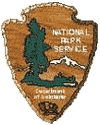

paleontologist Scott Foss working on a fossil near Rhino Hill
Return to Rhino Hill
by Delda Findeisen, JODA Staff - 10/98
We were "head hunting" at Rhino Hill! A camera crew from Harper's Ferry* would be coming in the next week to shoot a new NPS film, and we needed to find macrovertebrates that would look good on screen. This was not our only motivation. The area hadn't been prospected since 1989, and was ready to be explored again. Significant erosion had occurred, making it difficult to locate certain ridges and ravines on the aerial photographs, but this erosion had hopefully exposed new fossils.
Rhino Hill is part of Blue Basin, an area rich in fossils which lies in the heart of Turtle Cove. Thomas Condon, first to recognize the scientific significance of fossils found in exposures cut by the John Day River, called the valley between Kimberly and Picture Gorge ‘Turtle Cove', after the abundant prehistoric tortoise remains discovered in the area. Beginning in 1862, Condon discovered many wondrous fossils in the John Day Fossil Beds, attracting the attention of paleontologists from the east.
Though "scientifically incorrect" today, the 1800's was often an era of "head hunting" by professional fossil collectors. If little care is taken when fossils are collected, parts of the story are lost. Partial retrieval and poor field notes are two of the biggest problems.
Charles H. Sternberg, a respected and conscientious fossil hunter of the late 1800's, was an early pioneer in the field of making complete collections. In his autobiography, "The Life of a Fossil Hunter," Sternberg recalls working in the John Day Fossil Beds in 1878:
"…we would run across a pile of broken bones and a hole from which a skull had been taken. When I asked Bill what he had meant by leaving the bones of the skeleton behind, he answered, ‘We were only looking for heads, though we sometimes saved the knucks and jints.' This accounts for the scarcity of skeletons among the first collections made. I saw to it that my party should care for every bone discovered."
In order to reconstruct a fossil animal, to give it flesh and blood and a way of life, as much information as possible must be obtained. A single fossil skull can tell scientists a lot about a critter, such as what it ate and possibly its role in the environment (plant eater vs. meat eater). A fossil skull with other parts of its skeleton can tell a much broader story. It can tell us how it walked or stalked its prey, how it dug burrows or climbed trees, or how it defended itself from predators. It can also show how it may have evolved through time, piece by piece, such as how the ear bones of a mammal may have evolved from part of the jaw in mammal-like reptiles.
The 1989 party, led by JODA paleontologist Ted Fremd, had collected seven different species from Rhino Hill. Our party this year, again led by Ted Fremd, collected at least nine different kinds of pre-historic animals, including several mammals (squirrel, mouse-deer, canid, nimravid, oreodont, rhinoceros, horse), a reptile (snake vertebrae) and an invertebrate (snail). Some days you don't find anything, but other days you hit the jackpot!
Fossil head hunting today is quite a bit different from the days of Sternberg. True, we were after the pretty and impressive fossils for the film, but any critter found was entirely excavated and detailed notes were taken. Even the small, "unimpressive" fossils were collected.
Detailed field notes must be obtained in order to place the fossil in the right context. Geographic location, stratigraphic horizon, associated fossils and rocks, and orientation are only a few of the clues used to reconstruct the prehistoric ecology and geology millions of years ago. These notes are just as important in reconstructing the past as the fossils themselves are. To only have the fossil itself, is like having a character without a plot.
Thirty to forty percent of vertebrate specimens known from the John Day Fossil Beds are from the Blue Basin area, although the area represents only five percent of the time portrayed in the John Day Fossil Beds. Much of the present work aims to collect from the lesser-known areas of the region. The John Day Fossil Beds contain an excellent record of the Age of Mammals with fossils showing how flora and fauna responded to climatic and geologic changes for over 45 million years in eastern Oregon.
Not only heads are hunted. Evidence of legs, tails, spines, feet, claws, leaves, seeds, insects, soils, lakes, streams, mountains, nests, burrows, and footprints from Long Ago are all collected by hunters in search of the past, in an effort to better understand Oregon, North America, and the earth itself.
*Note: Harper's Ferry is the NPS design center where new exhibits and films for park service sites are produced….
paleonews/4.htm
Last Updated: 09-Jan-2000